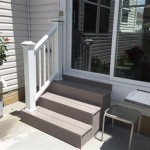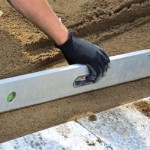Cement Patio Slabs: A Comprehensive Guide
Cement patio slabs, also known as concrete pavers or paving stones, represent a durable and versatile option for creating aesthetically pleasing and functional outdoor living spaces. Their widespread use stems from their ability to withstand diverse weather conditions, offer design flexibility, and provide a cost-effective alternative to other patio materials such as natural stone or wood decking. Understanding the different types, installation methods, and maintenance requirements of cement patio slabs is crucial for ensuring a long-lasting and visually appealing patio.
The composition of cement patio slabs primarily consists of cement, aggregate (e.g., sand, gravel, or crushed stone), water, and often, admixtures. The specific proportions of these components, alongside the manufacturing process, determine the slab's strength, durability, and aesthetic characteristics. Admixtures, such as pigments, reinforcing fibers, or water-reducing agents, are frequently incorporated to enhance the slab's properties, influencing its color, texture, and resistance to cracking or freeze-thaw cycles.
The manufacturing process generally involves mixing the constituent materials, pouring the mixture into molds, and allowing it to cure. Curing is a crucial step that promotes the hydration of cement, leading to the development of strength and hardness. Different manufacturing techniques, such as wet-cast or dry-cast methods, produce slabs with varying densities, textures, and surface finishes. Wet-cast slabs typically exhibit a smoother, more refined surface, while dry-cast slabs often possess a more textured, rustic appearance.
Types of Cement Patio Slabs
The market offers a diverse range of cement patio slabs, each with unique characteristics and applications. Understanding these differences is essential for selecting the appropriate slab type for a specific patio project. Factors such as desired aesthetic, budget constraints, and the anticipated level of traffic should influence the selection process.
One common classification is based on the size and shape of the slabs. Options range from small, square pavers to large, rectangular slabs. The choice of size and shape can significantly impact the overall aesthetic of the patio. Smaller pavers often create a more intricate, patterned appearance, while larger slabs offer a cleaner, more contemporary look. Irregularly shaped slabs, sometimes referred to as flagstone pavers, can mimic the appearance of natural stone, providing a more organic and rustic feel.
Another important distinction lies in the surface texture and finish of the slabs. Smooth-surfaced slabs are easy to clean and maintain, making them suitable for high-traffic areas or spaces where spills are frequent. Textured slabs, on the other hand, provide better slip resistance, which is particularly important in areas that are exposed to moisture or ice. The texture can be achieved through various methods, such as stamping, brushing, or incorporating aggregates into the surface of the slab.
Colored cement patio slabs offer a wide range of design possibilities. Pigments can be added to the concrete mix to create slabs in virtually any color, allowing for seamless integration with the surrounding landscape or architectural style. Integral coloring, where the pigment is mixed throughout the entire slab, provides a more consistent and long-lasting color. Alternatively, surface staining or sealing can be used to add color or enhance the existing color of the slabs.
Installation of Cement Patio Slabs
Proper installation is paramount for ensuring the longevity and stability of a cement patio. A well-installed patio will resist settling, cracking, and weed growth, providing a safe and enjoyable outdoor space for years to come. While professional installation is often recommended, homeowners with some experience in construction can successfully install a cement patio themselves, provided they follow proper procedures and use appropriate tools.
The first step in the installation process is site preparation. This involves clearing the area of any vegetation, rocks, or debris. The soil should then be excavated to a depth that allows for the base material, the pavers, and a slight slope for drainage. The typical excavation depth is around 6-8 inches, but this may vary depending on the soil type and the thickness of the pavers.
Next, a compacted base layer is crucial for providing a stable foundation for the pavers. This base typically consists of crushed stone or gravel, which should be compacted in layers using a plate compactor. A properly compacted base will prevent the pavers from shifting or settling over time. The thickness of the base layer should be at least 4 inches, but may need to be thicker in areas with poor soil drainage or heavy traffic.
After the base layer is compacted, a layer of leveling sand is spread evenly over the surface. This sand layer provides a smooth and even surface for the pavers to rest on. The sand should be screeded to ensure a consistent thickness, typically around 1 inch. It is important to use leveling sand specifically designed for paver installation, as regular sand may not provide adequate drainage or stability.
The pavers are then laid on top of the leveling sand, following a desired pattern or design. Spacers are often used to ensure consistent spacing between the pavers. Once the pavers are laid, they should be tamped down gently with a rubber mallet to ensure they are firmly seated in the sand. After all the pavers are in place, polymeric sand is swept into the joints between the pavers. This sand hardens when wetted, creating a tight seal that prevents weed growth and stabilizes the pavers.
Edging restraints are essential for preventing the pavers from shifting or spreading over time. These restraints can be made of plastic, metal, or concrete, and are installed around the perimeter of the patio. The edging restrains provide a physical barrier that keeps the pavers in place and maintains the shape of the patio.
Maintenance of Cement Patio Slabs
Regular maintenance is essential for preserving the appearance and extending the lifespan of a cement patio. While cement patio slabs are relatively durable, they are still susceptible to staining, fading, and weed growth. Implementing a consistent maintenance routine will help to minimize these problems and keep the patio looking its best.
One of the most important maintenance tasks is regular cleaning. Sweeping the patio regularly removes dirt, leaves, and other debris that can stain or discolor the pavers. For more stubborn stains, a mild detergent and water can be used. A pressure washer can also be used to clean the patio, but it is important to use a low-pressure setting to avoid damaging the pavers.
Sealing cement patio slabs can provide additional protection against staining, fading, and water damage. A sealant creates a barrier that prevents liquids from penetrating the surface of the pavers. There are various types of sealants available, including penetrating sealants and topical sealants. Penetrating sealants soak into the pavers and provide protection from within, while topical sealants form a protective layer on the surface.
Weed control is another important aspect of patio maintenance. Weeds can grow in the joints between the pavers, detracting from the appearance of the patio and potentially destabilizing the pavers. Polymeric sand helps to prevent weed growth, but it may need to be reapplied periodically. Herbicides can also be used to control weeds, but it is important to use them carefully to avoid damaging the surrounding plants or landscaping.
In areas with harsh winters, it is important to take precautions to protect the patio from freeze-thaw damage. Avoid using de-icing salts, as these can damage the pavers. Instead, use sand or gravel to provide traction on icy surfaces. Snow should be removed from the patio regularly to prevent the buildup of ice and snow.
Periodically inspecting the patio for cracks, chips, or other damage is also important. Small cracks can often be repaired with a concrete patch compound. Larger cracks or more severe damage may require more extensive repairs, such as replacing the damaged pavers. Addressing damage promptly will prevent it from worsening and extending the lifespan of the patio.
Choosing the right cement patio slabs involves considering factors such as aesthetics, durability, budget, and maintenance requirements. The vast array of styles, colors, and textures available allows homeowners to tailor their patio to their specific tastes and needs. Proper installation and regular maintenance are crucial for ensuring a long-lasting and visually appealing patio that enhances the outdoor living experience.

Las Mejores Baldosas Para Exteriores Stone Tile

10 Ideas De Grama Losas En Cemento Piso Para Patio Diseño Concreto

10 Ideas De Grama Losas En Cemento Piso Para Patio Diseño Concreto

The Home Cómo Construir Un Camino De Losas

Pisos De Cemento Para Patio 15 Ideas Increíbles Y Económicas

Losas De Hormigón Para Exteriores Baldosas Antideslizantes Jardín

Losas Jardín Pizarra Hormigón Y Gres Porcelanico

Las Mejores Baldosas Para Exteriores Stone Tile

Coloca Pavers De Concreto Alrededor La Piscina

Como Hacer Losa De Patio En Cemento Parte 1








